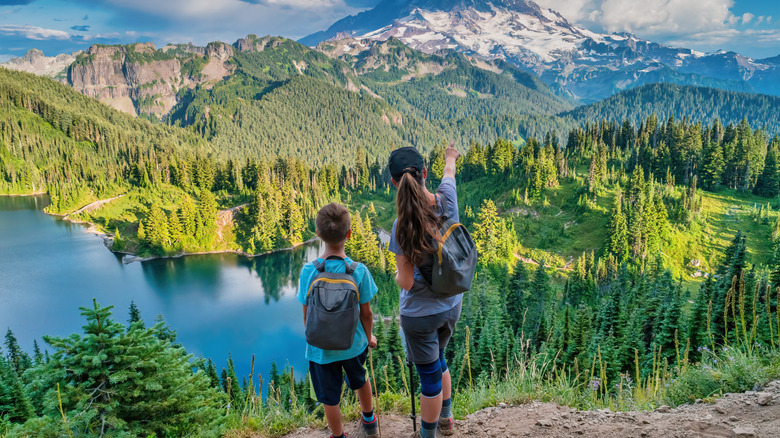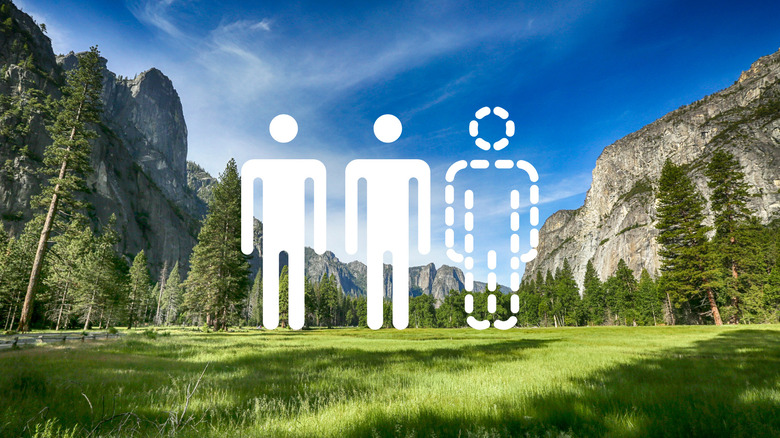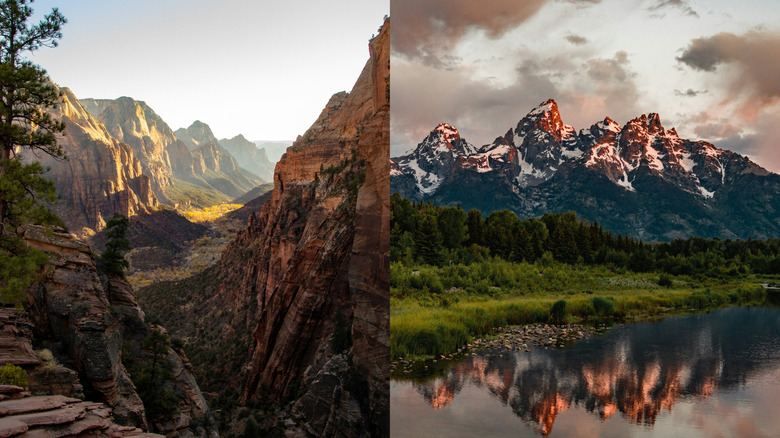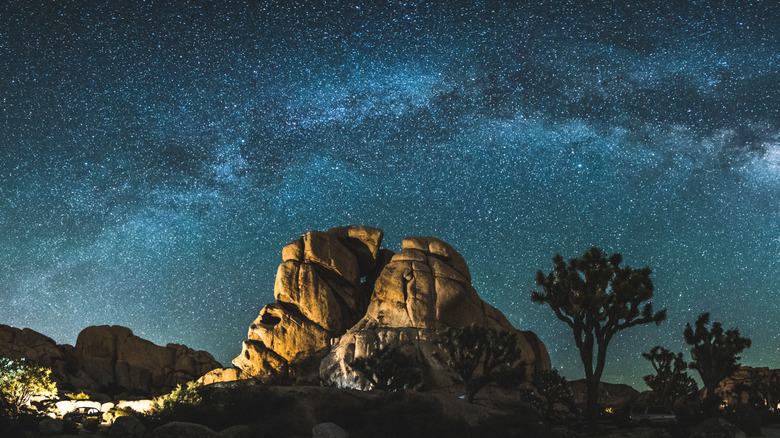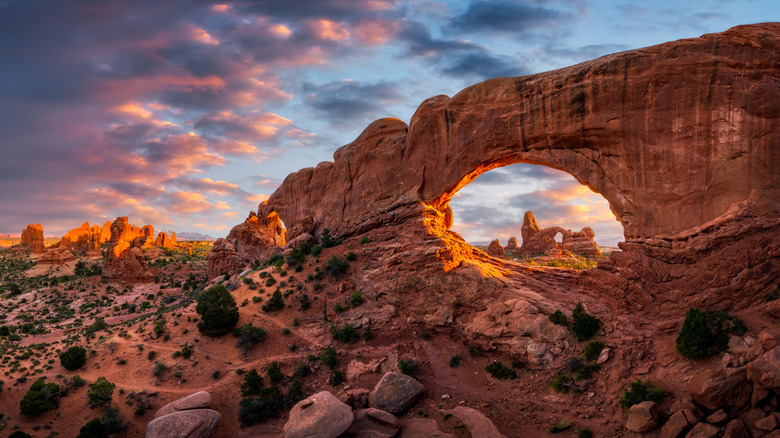What All These National Park Changes Mean For Your Visit To One This Summer
America's national parks have long been seen as "the best idea we ever had," a phrase immortalized by writer Wallace Stegner in 1983. "Absolutely American, absolutely democratic," Stegner continued, "they reflect us at our best rather than our worst." The United States National Park Service (NPS) was established on August 25, 1916, and since then, it has served as both the cornerstone and symbol of a nationwide conservation movement, a lasting jewel in the crown of American civic pride and identity. Over a century later, however, those ideals are showing signs of strain like never before.
In February 2025, the NPS and the U.S. Forest Service were forced to lay off thousands of staff as part of President Donald Trump's push to cut costs across federal agencies. Maintenance workers, cleaning staff, and park educators were included in the layoffs, leaving many concerned that NPS leaders will face difficult decisions about public safety, land management, and even operating hours.
In March, the government provided NPS workers with talking points urging them to reassure visitors that the quality of their experiences in the park would not suffer as a result of these changes and instructing them to avoid linking any closure of park services to staffing issues. However, an analysis conducted by the National Parks Conservation Association called the reductions "simply unsustainable" and found that, as of July, the NPS has seen a 24% decline in permanent staff since the Trump administration took office earlier in the year. So, who's right — and what can you expect if you visit one of the country's hundreds of national parks this summer?
What park visitors will notice this summer
It takes a small army of workers to maintain all 428 national parks in America, partly because more than 331 million people visited them last year alone. But as staff numbers fall and employees prepare for more proposed budget cuts (more on those later), keeping the parks clean, organized, and safe has become a near-impossible task. As a result, canceled youth camps, dirty restrooms, unmaintained trails, and even delayed emergency response are all on the table this summer for visitors looking to experience the great American outdoors.
Some effects have been even more acute; the complex of buildings at Yosemite National Park's Pioneer History Center was recently forced to shut down in the aftermath of artifact looting, for example, and the beach at Assateague Island National Seashore in Maryland and Virginia will go without its team of lifeguards, who rescued 24 people last year alone, this season. At Crater Lake National Park, visitors may want to savor the famous Cleetwood Cove Trail while they can; in June, a rockslide took out portions of the path, and a skeleton crew worked overtime to get it open in time for the Fourth of July holiday. The trail will close for three years for repairs when this season ends, a timeline that could easily stretch even longer.
The government is also canceling dozens of Park Service building leases that house museums, law enforcement facilities, educational centers, and more in the coming weeks and months. Some buildings act as visitor contact centers, which provide orientation materials and, more crucially, are a place for visitors to escape the heat or cold during their visit. Overall, expect less on your visit: fewer staff, fewer services, and fewer opportunities to properly experience these national treasures.
The uneven impact of National Park System cuts
Not all national parks are likely to feel the cuts in the same way. Larger, high-profile locations are better situated to weather the current situation thanks to strong private donor networks and NPS partner groups, which may help offset staffing shortfalls to some degree. Smaller or less-visited parks — like those in our list of national parks to visit if you want to avoid the crowds — can lack these resources, meaning your experience this summer may heavily depend on where you choose to go.
The Yosemite Conservancy, for example, has contributed more than $172 million in grants to Yosemite National Park over the years to support critically needed trail rehabilitation, habitat restoration, and wildlife protection programs. In 2024, Yellowstone also benefited from a $40 million donation from the National Park Foundation to build employee housing.
Smaller and less popular parks and attractions in the NPS can lack such financial cushioning and are already facing visible operational limitations. The Gates of the Arctic National Park, despite being the second largest national park in the country, is the least visited and operates with only a few dozen staff members during high season, so any role reductions have an outsized effect on its day-to-day operations. At the NPS Alaska Regional Office, layoffs mean there is now a single individual leading the state's entire archaeology and cultural resource protection initiatives, and only a small team remains to liaise with Indigenous tribes in the region whose ways of life depend on the integrity of these parks.
The resilience of our national parks
While federal cuts are squeezing the National Park Service, regular citizens and private groups are stepping up where the government is stepping back. In the months since President Trump's administration began slashing staff and proposing sweeping future budget reductions, a number of nonprofit partner groups have seen an increase in both donations and volunteer interest.
For example, in the spring of 2025, Shenandoah National Park saw more than three times the number of volunteer inquiries that it received just a year prior. And the nonprofit group associated with Acadia National Park, the Friends of Acadia, filled its 350 summer volunteer positions in record time. Support from nonprofits like these is no small contribution. It often means that parks can afford to run programs that keep trails safe and open and provide educational opportunities for the park's younger visitors.
But no amount of volunteers or private donations can eclipse the role government funding plays in these parks' operation. The kinds of positions that national parks hire for require highly trained, experienced individuals. Because of this, the stress from recent staffing shortages is causing the nonprofits that support the NPS to consider funding full-time park staff positions to help make up for the shortfalls.
How you can support the National Park Service
The short- and long-term outlook for the National Park Service is not good. On July 8, the Supreme Court lifted a federal injunction issued by San Francisco U.S. District Judge Susan Illston that had paused President Trump's mass-layoff push, effectively clearing the way for more. The administration's federal budget plan for 2026 likewise calls for more than $1 billion in budget cuts to the NPS, the largest cut in its history. As Theresa Pierno, President and CEO of the National Parks Conservation Association, recently explained in a statement provided by the organization, "Quite simply and astonishingly, this is dismantling the National Park Service as we know it, ranger by ranger and brick by brick."
So, what can outdoor lovers do? The simplest answer is to visit them, and not just for the parks' sake, either. Visitors to Alaska's national parks, for example, bring in an estimated $2 billion to the state economy and support roughly 19,000 jobs. Shopping the local businesses that depend on national park tourism is just as important as supporting the parks themselves. Consider heading to lesser-known parks to experience something different while putting your money where it will have the greatest impact.
It also helps to brush up on outdoor safety protocols and the principles behind the Leave No Trace outdoor ethical framework. With park capacities reduced or severely limited, the best way to avoid having to guess if a park's emergency services are at capacity is to enjoy these parks responsibly. If you're going alone, familiarize yourself with the safety tips you should know before taking a solo hike. Despite the challenges, you can still make lifelong memories visiting the country's incredible national parks — and now, more than ever, you can make a difference in them, too.
